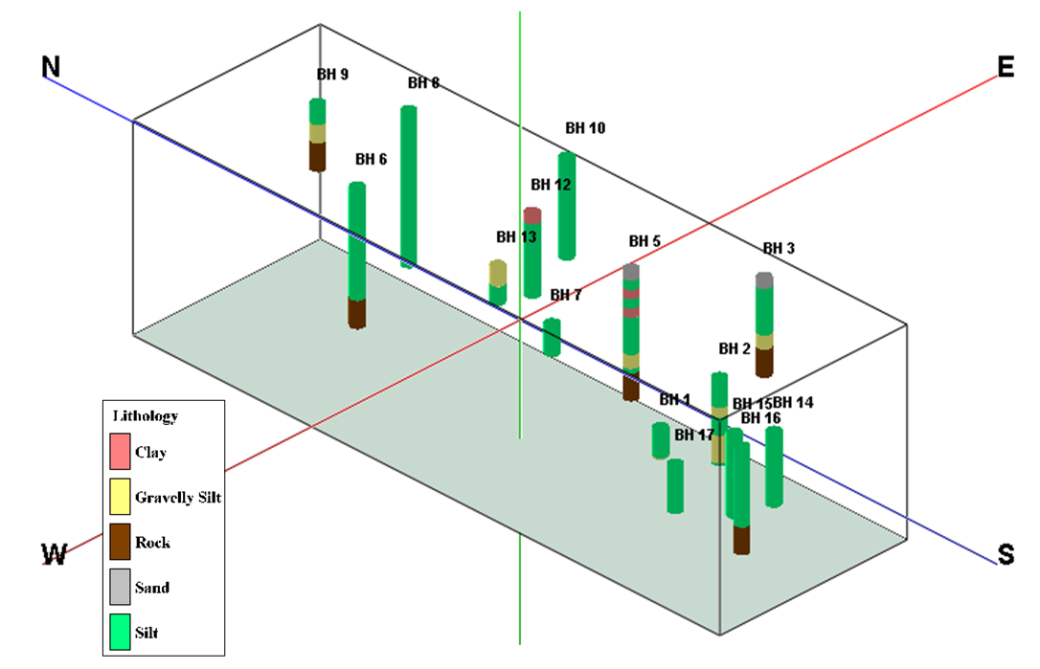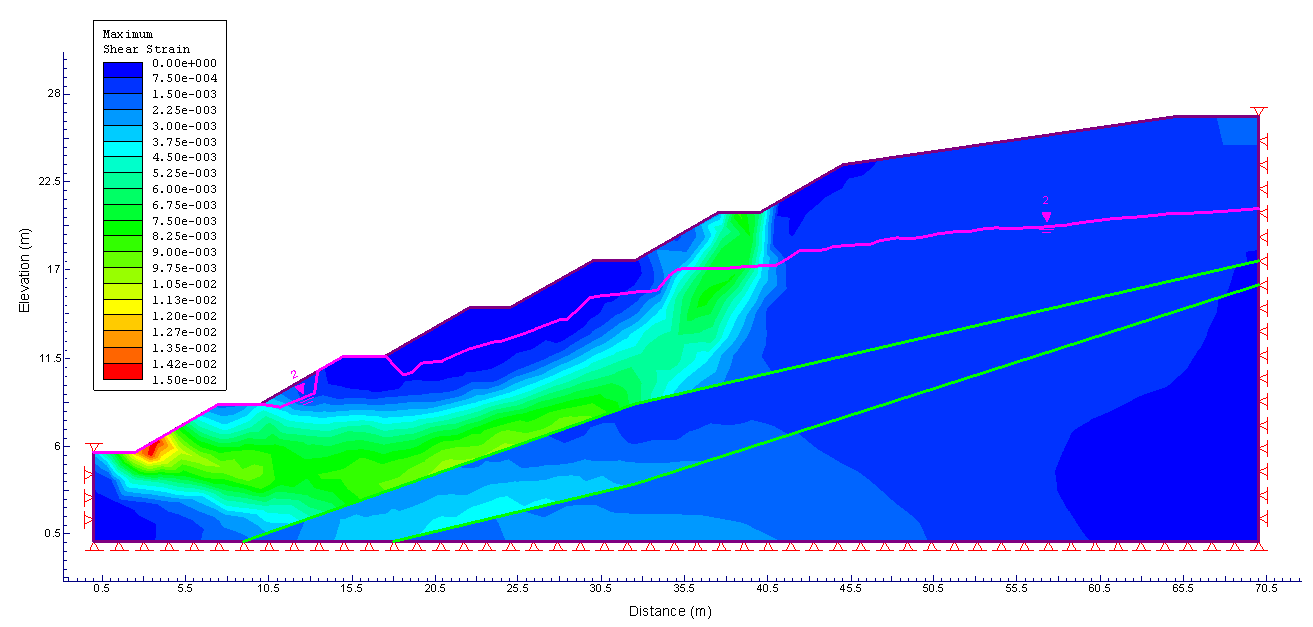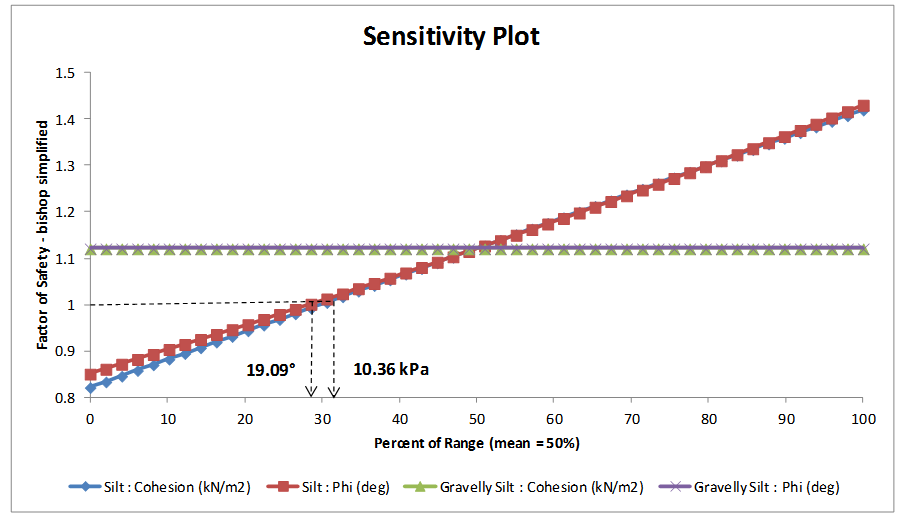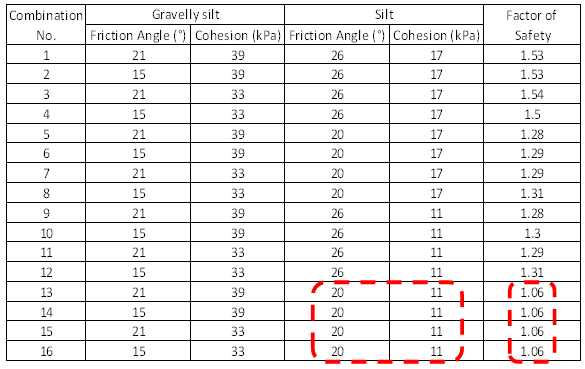-
Paper Information
- Next Paper
- Previous Paper
- Paper Submission
-
Journal Information
- About This Journal
- Editorial Board
- Current Issue
- Archive
- Author Guidelines
- Contact Us
Journal of Civil Engineering Research
p-ISSN: 2163-2316 e-ISSN: 2163-2340
2014; 4(3A): 31-35
doi:10.5923/c.jce.201402.04
Back Analysis of Slope Failure Using Finite Element with Point Estimate Method (FEM-PEM)
Soon Min Ng, Mohd Ashraf Mohamad Ismail, Ismail Abustan
School of Civil Engineering, Universiti Sains Malaysia (USM), Engineering Campus, Pulau Pinang, Malaysia
Correspondence to: Soon Min Ng, School of Civil Engineering, Universiti Sains Malaysia (USM), Engineering Campus, Pulau Pinang, Malaysia.
| Email: |  |
Copyright © 2014 Scientific & Academic Publishing. All Rights Reserved.
This paper investigates the slope failure in Precinct 9, Putrajaya, Malaysia by using numerical back analysis method. The catastrophic slope failure was triggered by a cumulative rainfall of 210 mm that occurred 2 days before the occurrence of slope failure. Site investigation that includes borehole sampling was immediately conducted to obtain representative information for the study area. The slope can be divided into 3 layers namely gravelly silt, silt and bedrock. Due to the uncertainty about the actual cause of failure initiation, back analyses have been performed via finite element shear strength reduction method for considering various probable mechanisms. In order to deal with the uncertainty and variability of the soil parameters, the Point Estimate Method (PEM) approach that assumed a normal and uncorrelated distribution was adopted in this study. Analysis results show that the slope failure is mainly influenced by the shear strength of the silt layer where the cohesion and friction angle at failure were 11 kPa and 20° respectively. Besides, the modeled circular slip surface also agrees well with the observed one.
Keywords: Back analysis, Slope failure, Shear strength reduction, Point estimate method
Cite this paper: Soon Min Ng, Mohd Ashraf Mohamad Ismail, Ismail Abustan, Back Analysis of Slope Failure Using Finite Element with Point Estimate Method (FEM-PEM), Journal of Civil Engineering Research, Vol. 4 No. 3A, 2014, pp. 31-35. doi: 10.5923/c.jce.201402.04.
Article Outline
1. Introduction
- The analysis carried out to identify the cause of slope failure in known as back analysis. It can be utilized to determine the shear strength parameters, pore water pressure and other conditions at the time of failure. Generally, back analysis is an effective approach to provide an insight into the underlying failure mechanism and improve the understanding regarding the factors controlling the stability of slopes. One of the advantage of back analysis is it can account for important factors that may not be well represented in laboratory and in-situ tests such as the presence of cracks and pre-existing shear planes within the soil mass [1]. Besides, the scale for back analysis is also much larger compared to the materials that are in at in-situ state [2]. However, there are also some uncertainties in back analysis approach that must be considered. For examples, mechanism of progressive slope failure, information of pore water pressure and the exact slip surface location and geometry [3]. Two methods that can be used to perform back analysis are deterministic and probabilistic method. Deterministic method determines a unique set of parameter such as c and
 by considering the factor of safety equals to unity [4]. However, in order to deal with the uncertainties in back analysis, probabilistic method offers a better approach to analyze a multiple sets of parameters simultaneously [5]. The outcomes are numerous combinations of parameters that result in slope failure. Nevertheless, the results of probabilistic method are realistic if the input parameters were correctly statistically characterized [6].In this paper, a systematic approach of back analysis is proposed using the probabilistic method. The objective of this study is to identify a range of possibilities that cause slope failure from the available information and to determine the suitable parameters that can be used for designing remedial works. The reliability of this approach is demonstrated by applying it to a case study of slope failure in Putrajaya, Malaysia.
by considering the factor of safety equals to unity [4]. However, in order to deal with the uncertainties in back analysis, probabilistic method offers a better approach to analyze a multiple sets of parameters simultaneously [5]. The outcomes are numerous combinations of parameters that result in slope failure. Nevertheless, the results of probabilistic method are realistic if the input parameters were correctly statistically characterized [6].In this paper, a systematic approach of back analysis is proposed using the probabilistic method. The objective of this study is to identify a range of possibilities that cause slope failure from the available information and to determine the suitable parameters that can be used for designing remedial works. The reliability of this approach is demonstrated by applying it to a case study of slope failure in Putrajaya, Malaysia.2. Project Background
- Putrajaya is the third federal territory of Malaysia that serves as the federal administrative centre for the country. It has approximately 49 km2 of land and was developed due to the congestion and overcrowding in Kuala Lumpur areas. A slope failure that involved 20 m height of man-made slope about 45° occurred on 22nd March 2007 at Precinct 9, Putrajaya. 23 vehicles were buried by the debris and 1000 residents were forced to vacate from their 15 stories apartment which is located 10 m from the failure zone. Prior to the slope failure that occurred at 4.30am, it had been raining heavily in Putrajaya since the evening of 20th March 2007 until the early morning of 22nd. The slope failure occurred on the western side of a 50m high hill with a 36 million water tank constructed on the crest. The study area is underlain by graphitic quartz mica schist from Kajang Formation. Based on historical site investigation, the rocks in this area consist of interbedded sandstone, shale and actinolite schist [7]. Fig. 1 shows the location of the slope failure in Precint 9, Putrajaya.
 | Figure 1. Location of slope failure and boreholes in Precint 9, Putrajaya |
3. Site Investigation
- The study commenced with desk study where data collection for hydrological, geological and topographical data were conducted. Rainfall data recorded by a rain gauge station located near to the study area show a high intensity of rainfall of 140mm and 60mm on 20th and 21st March 2007. The rainfall intensity on 22nd March 2007 which is the day of slope failure recorded only 10mm. A total of 17 boreholes drilling were carried out using rotary wash boring method immediately after the slope failure and their location are as shown in Fig. 1. The purpose of this borehole drilling was to determine the subsurface characteristics of the study area such as depth, groundwater level, lithology, and standard penetration (SPT) value and to collect soil sample for laboratory testing. Standard penetration test (SPT) was conducted in accordance to BS1377: Part 9: 1990 using a self tripping hammer of 63.5kg [8]. Initially, the tests were carried out at 1m interval from the ground surface to a depth of 6m and subsequently at every 1.5m intervals or when change of strata was encountered. Soil samples were collected in the form of disturbed and undisturbed samples to determine the soil parameters input for back analysis. Rock coring in accordance to BS5930: 1999 was also carried out when a rock layer is encountered [9]. The core recovery ratio (CRR) and rock quality designation (RQD) was recorded for each core run. Groundwater level in each borehole was measured using electric dipmeter when the drilling is in progress and after the completion of the boreholes. The borehole data were then utilized to develop a 3-dimensional multi boreholes logs model as shown in Fig. 2. This 3D model is able to show the types of soil that present in the study area and enable the development of conceptual model that will be used for back analysis.
 | Figure 2. 3-dimensional multi boreholes log |
4. Results and Discussions
- Generally, the slope consists of 3 layers namely silt, gravelly silt and bedrock. A conceptual model for the slope was developed as shown in Fig. 3. Point estimate method (PEM) developed by Rosenblueth (1975) [10] was used in this study to deal with the probabilistic inputs in slope stability analysis. The principle of PEM is to compute solutions at various estimation points and to combine them with proper weighting in order to get an approximation of the distribution of the output variables. The fundamental assumption to use PEM is all random variables are normally distributed. In this study, the numerical computation for PEM will be solved together with finite element shear strength reduction analysis using Phase2 software [11].
 | Figure 3. Conceptual model for the slope |
 | Figure 4. Slip surface computed with finite element shear strength reduction method |
|
|
 | Figure 5. Sensitivity plot via LEM-Monte Carlo probabilistic method |
5. Conclusions
- Based on the back analysis carried out, the stability of the slope in Precinct 9, Putrajaya is generally influenced by the silt layer. The shear strength parameters computed at the verge of slope failure are 11 kPa and 20° for cohesion and friction angle respectively. These threshold values can be utilized for remedial works such as installation of slope stabilization measures or designing a new slope under similar geotechnical conditions. This study also shows that the PEM approach is able to deal with the uncertainty and variability in FEM analysis. However, in order to maximize the use of PEM-FEM approach in back analysis, information should be combined from all possible sources such as laboratory testing, field instrumentation, and experience.
ACKNOWLEDGEMENTS
- The authors would like to express their appreciation to Universiti Sains Malaysia Research University (RU) Grant (1001/PAWAM/814192) for the financial support to carry out this research. In addition, the authors would also like to acknowledge Putrajaya Corporation and Kumpulan Ikram for the permission to carry out this research at the site and the cooperation given to make this research a success.
 Abstract
Abstract Reference
Reference Full-Text PDF
Full-Text PDF Full-text HTML
Full-text HTML
